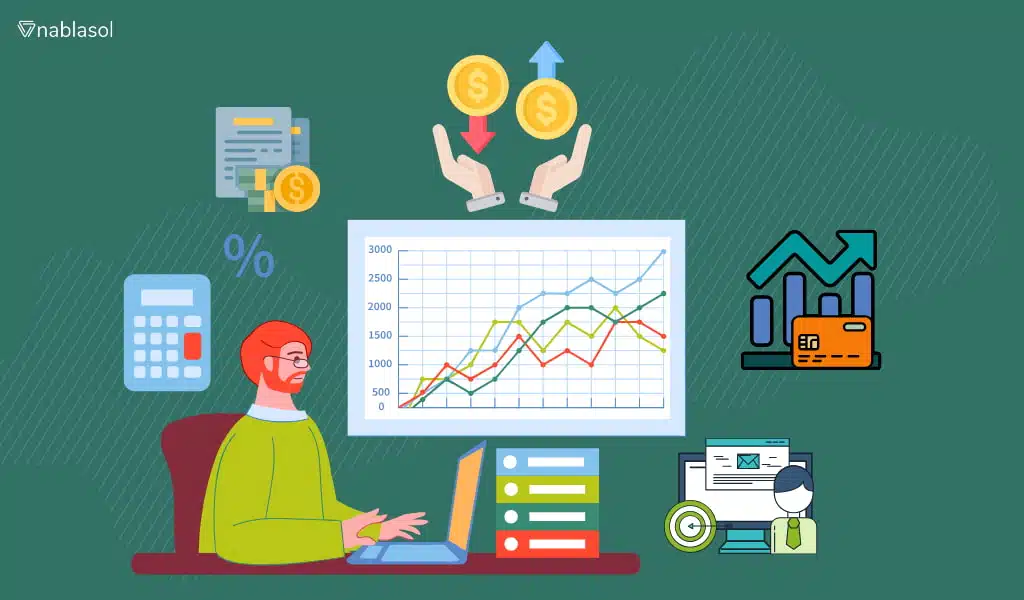Managing accounts receivable (AR) in the complex world of commercial finance requires more than just ensuring that bills are paid. It’s an extensive process that calls for careful credit management to maintain liquidity and boost profitability. It’s critical to comprehend the subtleties of accounts receivable and credit management as more and more firms move to automation. Here’s an overview of 6 efficient credit management techniques and how they work with automated accounts receivable to build a stable financial climate:
1. Approaches of Credit Assessment and Evaluation
Effective management of accounts receivable includes both credit assessment and review. The following are crucial approaches to determining and assessing credit:
Credit Scoring Models:
Based on the prospective customer’s payment history, financial history, and other relevant data, credit ratings are assigned to them using statistical models. This numerical score aids in forecasting the probability of timely payments.
Financial Statement Analysis:
To evaluate a potential customer’s financial standing, review their financial statements. Liquidity, profitability, and leverage ratios are important measures that reveal a company’s capacity to meet its monetary obligations.
Analysis of Credit History:
Examine consumer credit reports and histories obtained from the credit bureaus. Analyzing prior payment histories, current debt levels, and any instances of defaults or insolvencies are all part of this analysis.
Trade References:
To learn more about a customer’s payment habits and business conduct, contact other suppliers or creditors who have previously worked with them.
Bank References:
Through their banking links, potential customers’ financial state and reputation can occasionally be verified.
Credit Limit Algorithms:
Use techniques to establish dynamic credit limits according to requirements, such as the customer’s overall credit profile, payment history, and prior purchases.
Risk Categorization:
The use of credit evaluation to categorize consumers into distinct risk groups. This makes applying different credit management approaches for different risk levels easier.
Portfolio Analysis:
Examine every customer’s file to find trends and patterns in credit risk. This information can have an impact on more expansive lending rules.
External Economic Factors:
Any external economic factors and business trends that may affect a customer’s capacity to make payments and financial stability.
These methods give organizations a thorough understanding of the possible credit risk associated with every client, empowering them to decide on credit extension and accounts receivable management.
2. Setting Credit Limits: A Calculated Decision
Establishing appropriate credit limits requires careful consideration, which firms must manage. It entails taking into account previous payment patterns, industry standards, and prevailing economic situations. Automated accounts receivable process helps firms avoid risk while optimizing sales prospects by dynamically modifying these restrictions based on current information.
3. Importance of Defining Credit Terms and Conditions
Effective Accounting:
Explicit credit terms and conditions serve as the cornerstone of receivable control. The terms and timing of payments under these agreements affect the consistency of cash flow. By automating the processing of payables and invoices, these conditions can be standardized across platforms, ensuring compliance and reducing inconsistencies.
4. Managing Credit Risks and Defaults
Ensuring the viability of a firm and preserving financial health depends primarily on the effective management of credit risks and defaults. Here are five essential tactics for handling these difficulties:
Risk Assessment Tools:
Use modern data analysis and risk evaluation tools to keep an eye on each customer’s credit risk at all times. By using these technologies, firms can be proactive by anticipating probable defaults based on shifts in consumer preferences or macroeconomic situations.
Credit Policies and Guidelines:
Clearly outline the conditions of credit, criteria for eligibility, credit approval process, and steps to be taken in the event of defaults. These documents should be established. Regular audits and revisions of these policies are necessary, taking into account the company’s risk tolerance as well as the evolving economic conditions.
Customer Base Diversification:
By expanding the customer base, you can lower the concentration of risk. Steer clear of excessive dependence on a limited group of clients or specific sectors. In contrast, this might expose the company to major risks if these clients or industries experience downturns.
Consistent Communication and Follow-Ups:
Keep in constant contact with clients for information about their credit standing and anticipated payments. Personal follow-ups and automated reminders can aid in the prompt collection as well as the swift identification of any disagreements or problems.
Legal and Recovery Actions:
Create a methodical strategy for managing past-due accounts that includes negotiation talks, rearranging the terms of payment, and, as a last resort, filing lawsuits. A seasoned collection firm or legal counsel can recover bad debts without jeopardizing client relations.
By implementing these strategies into practice, companies can preserve cash flow and profitability by managing credit risks more skillfully and reducing the financial impact of defaults.
5. Impact on Profitability and Cash Flow
Ultimately, a company’s cash flow and profitability show how well its credit management is working. Streamlining the accounts receivable process, combined with efficient credit management, provides clear cash inflows and a reduction in bad debts. Organizations can spend with confidence in expansion prospects and operational improvements because of this stability.
6. Utilizing Automation for Receivables
Accounts receivable (AR) automation has revolutionized the way organizations manage their finances by giving them greater control, accuracy, and efficiency over cash flows. Here’s a closer look at how automation is transforming augmented reality workflows:
Simplifying the Processing of Invoices
Automation simplifies the entire invoice processing lifecycle. Automation solutions guarantee that all processes are executed efficiently, from creating invoices using pre-established templates and dispatching them automatically to tracking their progress. This additionally expedites the procedure while lowering the chance of human entry errors. Further enhancing cash flow management is the ability to set up automated follow-ups and reminders to guarantee on-time payments.
Enhanced Credit Administration
Credit scoring models that evaluate a customer’s creditworthiness in real time can be integrated into automated processes. These systems forecast prospective payment difficulties while offering advice on appropriate credit limits and conditions by utilizing historical data and predictive analytics. This proactive strategy lowers the likelihood of bad debt and mitigates risk.
Instantaneous Reporting and Analysis
Access to real-time financial information and statistical analysis is one of the biggest advantages of AR automation. Key performance metrics that businesses may swiftly track include days sales outstanding, account receivable turnover, and aging reports. Managers are able to respond immediately to changes in the financial situation or operational requirements by making well-informed judgments, thanks to their fast access to data.
Combining Financial Systems for Integration
Accounts receivable (AR) automation is frequently an element of a wider financial system that also includes payroll, budgeting, and AP. Integrating with these systems offers a thorough understanding of the financial standing of an organization. It allows data to move between departments smoothly, lowering the administrative load and improving accuracy. For example, accepted payments may automatically update the general ledger and reconcile bank statements, ensuring that financial records are always up-to-date.
Automating Payments and Receivables
The collection and processing of payments is also automated. Customers can pay invoices online using credit cards, ACH transfers, or digital wallets. Through online payment solutions that integrate with AR systems. This improves the client encounter while also speeding up the payment procedure. When it comes to collections, automated systems can rank accounts according to risk and past payments. Helps with concentrating resources where they are most needed.
Acceptance of Regulation and Safety
AR automation improves security and compliance protocols. Automated solutions assist make sure that organizations comply with increasingly rigorous requirements regarding data protection and financial reporting. They ensure that business policies and guidelines are applied consistently and keep an audit trail of every transaction. Furthermore, these systems are not effective without security measures like encryption and role-based access control, which guard critical financial data against unwanted access.
Conclusion
Incorporating comprehensive credit management strategies with accounts receivable operations in this fast-paced business environment is imperative. Businesses can improve their credit risk frameworks and optimize their financial operations while also securing long-term business growth and profitability by using accounts receivable automation. The route to financial resilience is obvious: use technology to improve established financial procedures. This can be achieved through enhanced credit evaluation methods, streamlined invoice processing, or linked AR and AP systems.
Automation has completely changed how companies handle accounts receivable by improving everything from credit risk analysis and real-time analytics to invoice processing. Proactive credit monitoring, more rapid and accurate invoice creation. Also, advanced risk management techniques that meet the organization’s risk thresholds and financial objectives are all made possible by these technologies. Businesses can devote more resources to strategic decision-making and customer relationship management. It will promote both growth and customer happiness by automating routine and repetitive processes.
In conclusion, A key component of financial strategy for businesses is navigating the complexities of international markets. Also, fluctuating economic conditions are the integration of complex accounts receivable operations with state-of-the-art automation systems. This integration strengthens the accounting bases of firms and increases the reliability and efficiency of the monetary process. It enables them to succeed over the long term and turn a profit in competitive settings.



